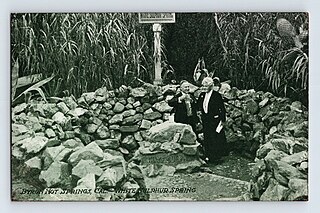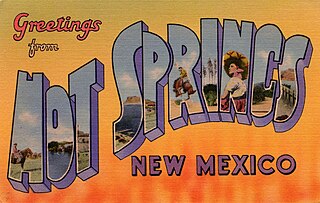
A spa town is a resort town based on a mineral spa. Patrons visit spas to "take the waters" for their purported health benefits.

Yessentuki is a city in Stavropol Krai, Russia, located in the shadow of Mount Elbrus at the base of the Caucasus Mountains. The city serves as a railway station in the Mineralnye Vody—Kislovodsk branch, and is located 43 kilometers (27 mi) southwest of Mineralnye Vody and 17 kilometers (11 mi) west of Pyatigorsk. It is considered the cultural capital of Russia's Greek population and close to ten percent of its population is of Greek descent. Population: 119,658 (2021 Census); 100,996 (2010 Russian census); 81,758 (2002 Census); 85,082 (1989 Soviet census).

A spa is a location where mineral-rich spring water is used to give medicinal baths. Spa towns or spa resorts typically offer various health treatments, which are also known as balneotherapy. The belief in the curative powers of mineral waters goes back to prehistoric times. Such practices have been popular worldwide, but are especially widespread in Europe and Japan. Day spas and medspas are also quite popular, and offer various personal care treatments.

Steamboat Springs is a small volcanic field of rhyolitic lava domes and flows in western Nevada, located south of Reno. There is extensive geothermal activity in the area, including numerous hot springs, steam vents, and fumaroles. The residential portions of this area, located mostly east of Steamboat Creek and south of modern-day SR 341, are now known simply as Steamboat.

A mud bath is a therapeutic spa treatment that involves soaking in a bath of warm mud, often in a natural hot spring or geothermal pool. Mud baths have been used for centuries as a way to promote health and relaxation, and are still popular today in many parts of the world.

The Széchenyi Medicinal Bath in Budapest is the largest medicinal bath in Europe. Its water is supplied by two thermal springs, one at 74 °C (165 °F) and the other at 77 °C (171 °F).

Tskaltubo is a spa resort in west-central Georgia. It is the main town of the Tsqaltubo Municipality of the Imereti province. It is known for its radon-carbonate mineral springs, whose natural temperature of 33–35 °C (91–95 °F) enables the water to be used without preliminary heating.

Jacumba Hot Springs is an unincorporated community in the Mountain Empire area of southeastern San Diego County, California, United States. For statistical purposes, the United States Census Bureau defined Jacumba as a census-designated place (CDP) for the first time in the 2010 census, with a population of 561. At the 2020 census, the population decreased to 540. The census definition of the area may not precisely correspond to local understanding of the area with the same name. The ZIP code is 91934 and the town lies within area code 619. Its elevation is 2,829 feet (862 m) above mean sea level (AMSL). On February 26, 2013, the United States Board on Geographic Names approved a petition by a citizen committee to change the town's name from Jacumba to Jacumba Hot Springs.

Sembawang Hot Spring Park is a natural hot spring and a public park in Singapore. It is located beside a military camp about 100 metres (330 ft) off the main road, Gambas Avenue. Like hot springs worldwide, it can have health healing properties with proper use in moderation, and its natural spring water had once been bottled commercially by Fraser and Neave, under the brand name of Seletaris. Since its discovery in 1909, the spring has been through a few changes of ownership and potential redevelopment proposals. The hot spring has a rural rustic feel for visitors to unwind from the hustle and bustle of the modern metropolitan city. The National Parks Board took over the ownership of the park for redevelopment, which officially reopened on 4 January 2020. Sembawang Hot Spring is one of two hot springs in Singapore, with the other located on Pulau Tekong.

Beppu Onsen (別府温泉) is an extensive hot spring system in the city of Beppu, Ōita, Japan. There are eight distinct major thermal spring zones called "Beppu Hatto".
Buckhorn Springs is an unincorporated community in Jackson County, Oregon, United States. It lies along Emigrant Creek in the Siskiyou Mountains southeast of Ashland. Buckhorn Springs Road connects the community to Oregon Route 66 near Emigrant Lake.

Byron Hot Springs is a hot spring system consisting of 57 spring sources. It was developed into a historic resort and retreat. During its heyday in the early 1900s the resort attracted movie stars and well-known athletes. It is now abandoned.

Truth or Consequences Hot Springs is a thermal spring system located in the Hot Springs Artesian Basin area of Truth or Consequences, New Mexico in Sierra County.

The Buckhorn Baths Motel at 5900 East Main Street at the corner of North Recker Road in Mesa, Arizona was a small mineral hot springs resort which offered a bathhouse as well as both cottages and motel rooms for overnight stays. Beginning in 1936 as a gas station and store, Ted and Alice Sliger developed the property into a resort complex which opened in 1939 and was virtually complete as of 1947. It continued to operate until 1999, when the bathhouse closed, although the motel and "Wildlife Museum" continued until 2004.

Radium Sulphur Springs, located on the north side of Melrose Avenue between Larchmont and Gower Street in Los Angeles, California, U.S., was an early-20th-century hot spring that resulted from an unsuccessful attempt to drill 1,500 feet (460 m) for oil. "Discovered" in 1905 and opened as a spa by G. P. Gehring in 1908, the owners claimed that the water was radioactive, germicidal, and blood purifying. The supposed radioactivity of water was advertised as "liquid sunshine" and was part of the larger radium fad of the early 20th century. The spa was located in Colegrove, an electric-railway stop and associated community just south of Hollywood.
Beverly Hot Springs is the only remaining natural geothermal hot spring within the center of the city of Los Angeles. It is located between Beverly Hills and downtown Los Angeles on what is now Oxford Avenue.

Paso Robles Hot Springs is a system of geothermal hot springs in the area of Paso Robles in San Luis Obispo County, California. They were developed in the late 19th and early 20th century.




















